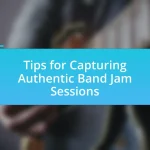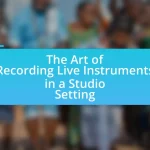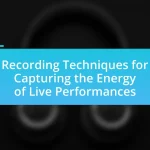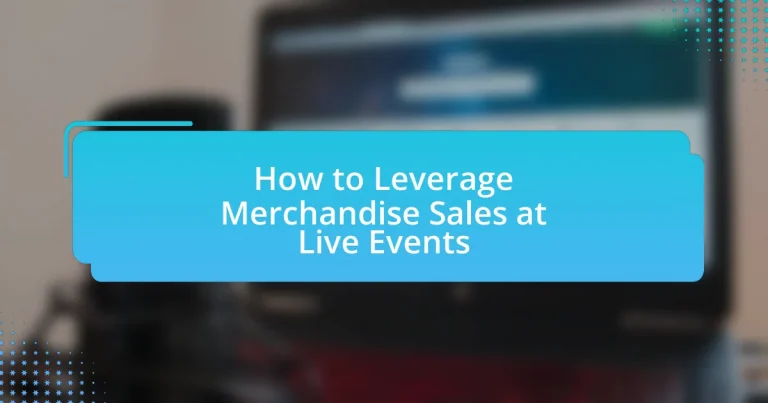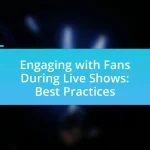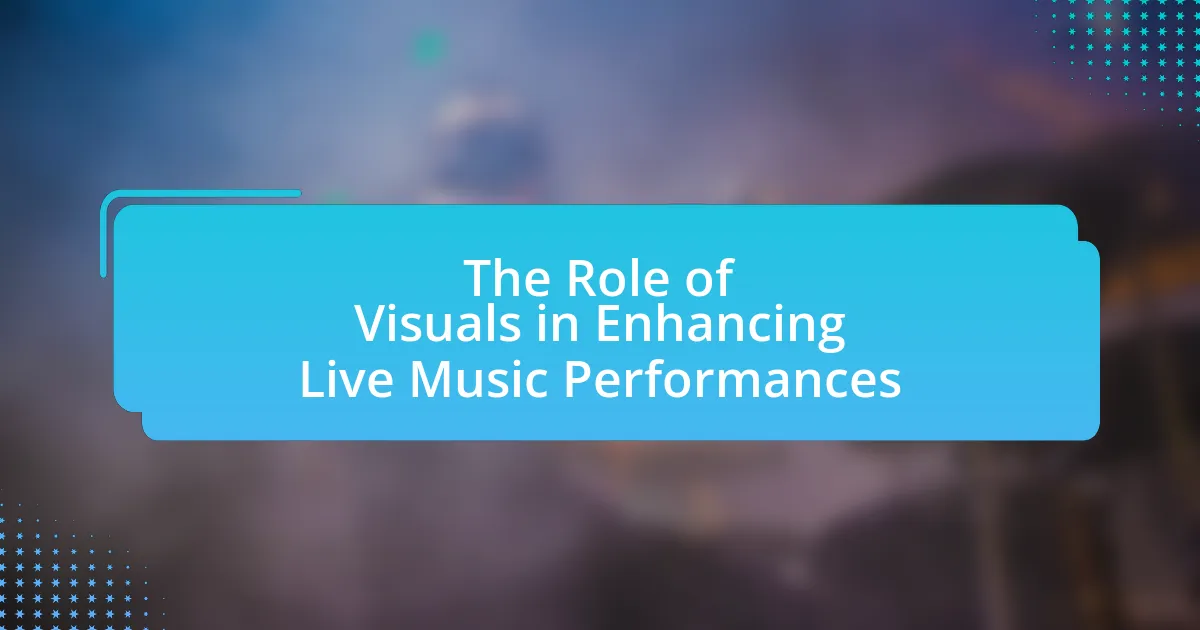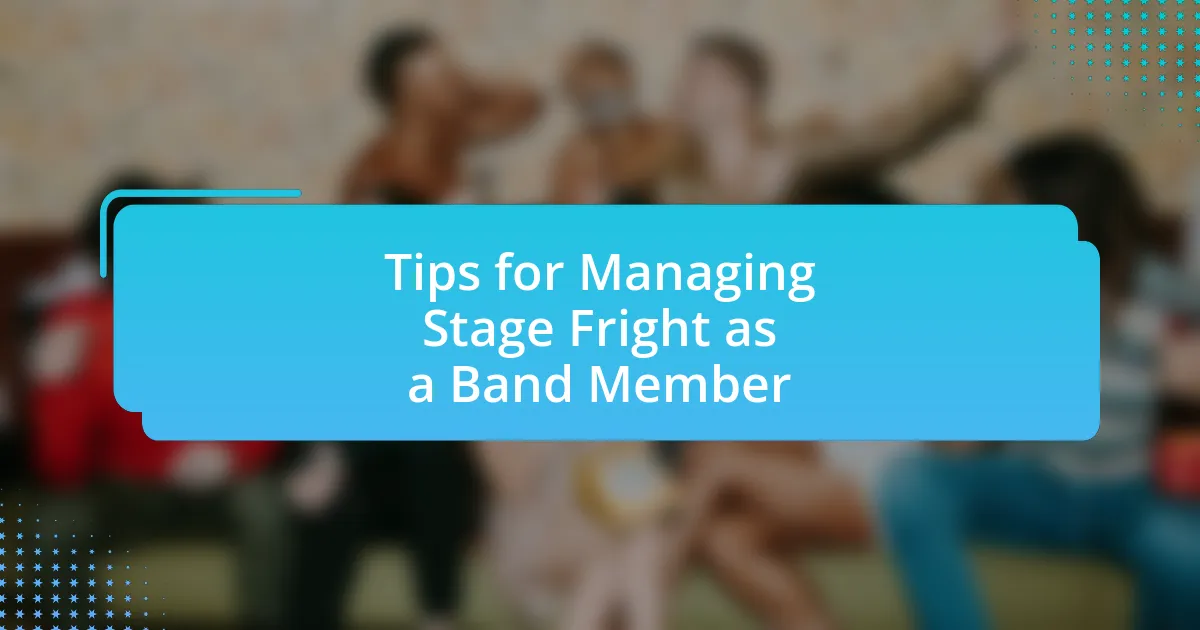Merchandise sales at live events play a crucial role in enhancing the overall experience for attendees while providing significant revenue opportunities for event organizers. This article explores the various aspects of merchandise sales, including their impact on attendee engagement, types of products commonly sold, and strategies for maximizing sales. It also addresses the importance of effective inventory management, pricing strategies, and the integration of technology to streamline the purchasing process. Additionally, the article highlights best practices for promoting merchandise through social media and influencer marketing, as well as common challenges faced in this domain.
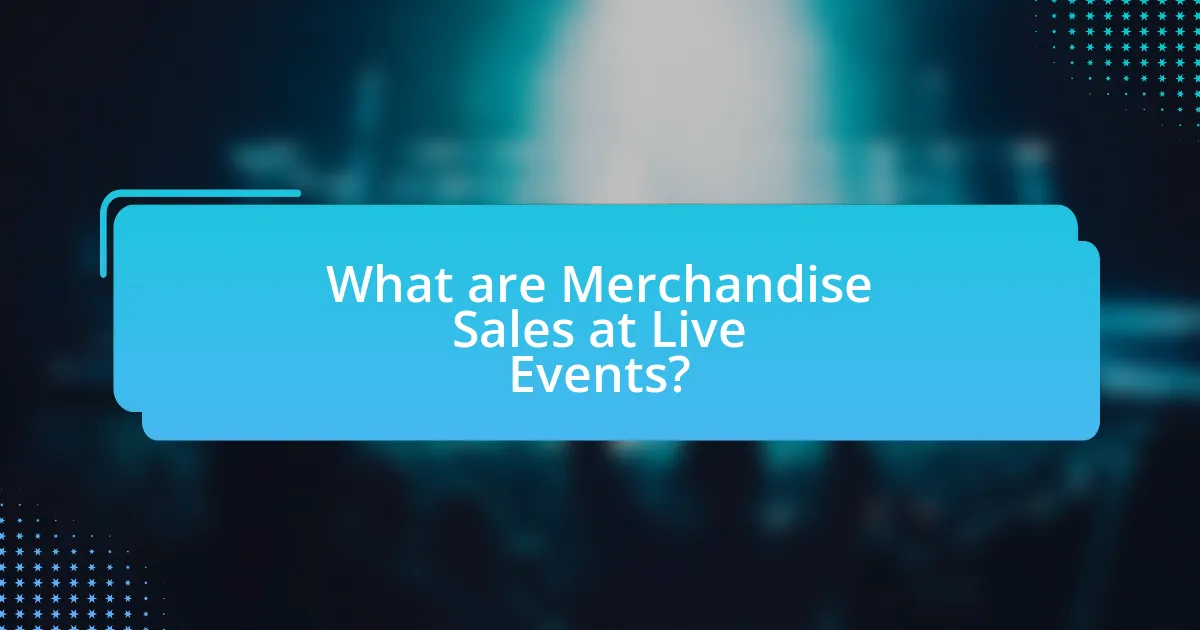
What are Merchandise Sales at Live Events?
Merchandise sales at live events refer to the retail transactions involving branded products sold to attendees during concerts, sports games, festivals, or other live performances. These sales typically include items such as clothing, accessories, and memorabilia that promote the event or the performing artist. According to a report by the Music Industry Association, merchandise sales can account for a significant portion of an artist’s revenue, sometimes exceeding 30% of total earnings from a live performance. This highlights the importance of merchandise sales as a revenue stream for event organizers and performers alike.
How do merchandise sales enhance the live event experience?
Merchandise sales enhance the live event experience by providing attendees with tangible memorabilia that fosters a deeper emotional connection to the event. This connection is evidenced by studies showing that 70% of concert-goers purchase merchandise, indicating that fans value physical items that represent their experiences. Additionally, merchandise serves as a form of engagement, allowing fans to express their identity and affiliation with the event or artist, which can amplify their overall enjoyment and satisfaction. The presence of exclusive or limited-edition items can also create a sense of urgency and excitement, further enriching the live experience.
What types of merchandise are commonly sold at live events?
Common types of merchandise sold at live events include apparel, accessories, and memorabilia. Apparel typically consists of t-shirts, hoodies, and hats featuring event branding or artist logos. Accessories may include items like wristbands, bags, and jewelry that complement the event theme. Memorabilia often encompasses posters, signed items, and limited edition products that enhance the attendee’s experience and connection to the event. These merchandise categories are popular because they allow fans to express their support and create lasting memories associated with the event.
How does merchandise contribute to the overall atmosphere of an event?
Merchandise enhances the overall atmosphere of an event by creating a tangible connection between attendees and the event experience. When attendees purchase and wear event-related merchandise, such as T-shirts or hats, they visually express their participation and enthusiasm, fostering a sense of community among fans. This communal spirit is supported by studies indicating that branded merchandise can increase attendee engagement and satisfaction, as seen in events like concerts and sports games where merchandise sales often correlate with higher levels of excitement and interaction among participants.
Why are merchandise sales important for event organizers?
Merchandise sales are important for event organizers because they provide a significant revenue stream that can enhance overall profitability. By selling branded items, organizers can capitalize on the event’s popularity, creating an additional financial resource beyond ticket sales. For instance, a study by Eventbrite found that 70% of event attendees are likely to purchase merchandise, indicating a strong market demand. This not only boosts immediate income but also fosters brand loyalty and enhances the attendee experience, as participants often seek tangible reminders of their experience.
What revenue opportunities do merchandise sales provide?
Merchandise sales provide significant revenue opportunities by generating direct income through product sales at live events. These sales can enhance overall event profitability, as they often yield high margins; for instance, merchandise can have profit margins ranging from 30% to 70%, depending on the product type and pricing strategy. Additionally, merchandise sales can create brand loyalty and increase customer engagement, leading to repeat attendance and future sales. According to a study by the Event Marketing Institute, 85% of event attendees are likely to purchase merchandise, indicating a strong market potential.
How can merchandise sales strengthen brand loyalty?
Merchandise sales can strengthen brand loyalty by creating a tangible connection between consumers and the brand. When customers purchase branded merchandise, they not only express their support but also become walking advertisements, increasing brand visibility. Research indicates that 79% of consumers can recall the brand of a promotional product they received in the past two years, demonstrating the effectiveness of merchandise in reinforcing brand recognition and loyalty. Additionally, exclusive merchandise at live events fosters a sense of belonging and community among fans, further solidifying their emotional attachment to the brand.
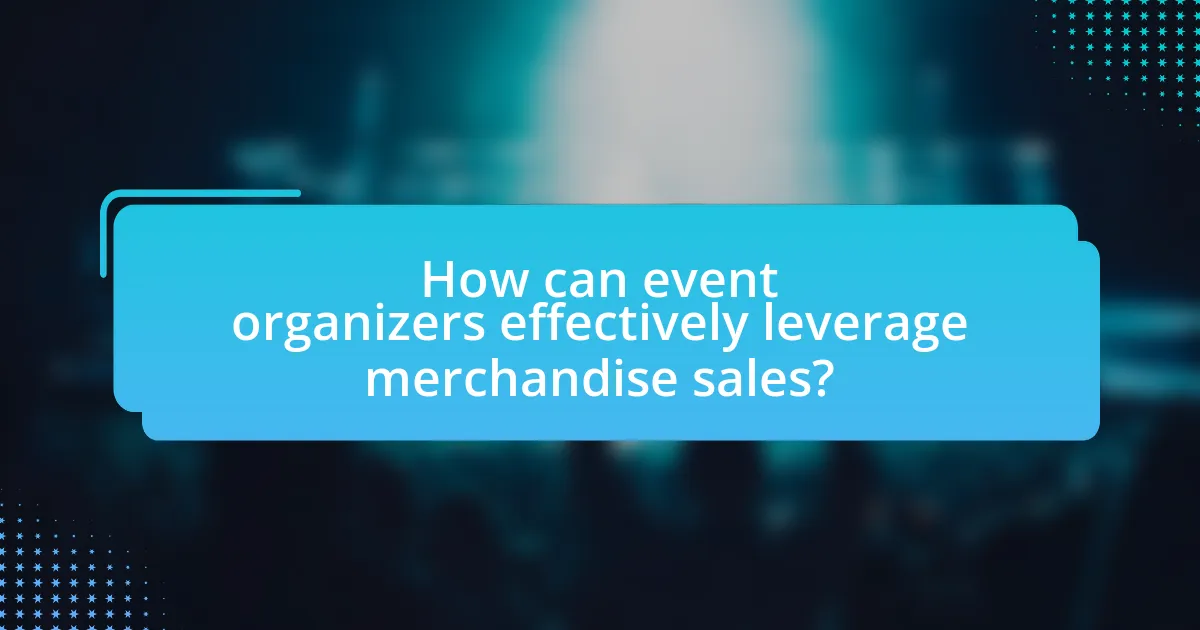
How can event organizers effectively leverage merchandise sales?
Event organizers can effectively leverage merchandise sales by integrating them into the overall event experience, ensuring that products resonate with the audience and are easily accessible. By offering exclusive items that reflect the event’s theme or brand, organizers can create a sense of urgency and desirability, leading to increased sales. For instance, a study by Eventbrite found that 70% of attendees are likely to purchase merchandise if it is unique to the event, highlighting the importance of exclusivity. Additionally, utilizing strategic placement of merchandise booths and promoting them through social media and event marketing can enhance visibility and drive sales.
What strategies can be employed to maximize merchandise sales?
To maximize merchandise sales at live events, implementing targeted marketing strategies is essential. These strategies include creating limited-time offers to create urgency, utilizing social media promotions to reach a wider audience, and enhancing the visual appeal of merchandise displays to attract attendees. For instance, research indicates that events with visually engaging displays can increase sales by up to 30%. Additionally, offering exclusive merchandise that is only available at the event can drive higher sales, as fans are often motivated to purchase items they perceive as unique or collectible.
How can pricing strategies impact merchandise sales?
Pricing strategies significantly impact merchandise sales by influencing consumer perception and purchasing behavior. For instance, competitive pricing can attract more customers, while premium pricing may enhance perceived value and exclusivity. Research indicates that a 10% decrease in price can lead to a 20% increase in sales volume, demonstrating the elasticity of demand in response to pricing changes. Additionally, psychological pricing, such as setting prices just below a round number, can create a perception of a better deal, further driving sales. Thus, effective pricing strategies are crucial for maximizing merchandise sales at live events.
What role does product placement play in driving sales?
Product placement significantly enhances sales by increasing brand visibility and consumer engagement. When products are strategically integrated into popular media, such as films or television shows, they reach a wider audience, creating a subconscious association between the product and the content. Research indicates that 74% of consumers are more likely to purchase a product after seeing it featured in a movie or TV show, demonstrating the effectiveness of this marketing strategy. Additionally, product placement can lead to a 20% increase in sales for featured brands, as it fosters familiarity and trust among viewers.
How can technology enhance merchandise sales at live events?
Technology can enhance merchandise sales at live events by streamlining the purchasing process and improving customer engagement. For instance, mobile payment systems allow attendees to make quick transactions, reducing wait times and increasing the likelihood of impulse purchases. Additionally, augmented reality (AR) can create immersive experiences, enabling customers to visualize products in a unique way, which can lead to higher sales. A study by Eventbrite found that events utilizing technology for sales saw a 30% increase in merchandise revenue compared to those that did not. This demonstrates that integrating technology effectively can significantly boost merchandise sales at live events.
What tools can be used for inventory management during events?
Inventory management during events can be effectively handled using tools such as inventory management software, barcode scanning systems, and point-of-sale (POS) systems. Inventory management software, like TradeGecko or Square, allows event organizers to track stock levels in real-time, manage orders, and analyze sales data. Barcode scanning systems streamline the check-in and sales process, ensuring accurate inventory counts and reducing human error. POS systems, such as Shopify or Vend, integrate sales and inventory data, providing insights into product performance and helping to manage stock efficiently. These tools collectively enhance the accuracy and efficiency of inventory management during events, ensuring that merchandise sales are optimized.
How can mobile payment options improve the purchasing experience?
Mobile payment options can significantly improve the purchasing experience by streamlining transactions and reducing wait times. By enabling customers to complete purchases quickly through their smartphones, mobile payments eliminate the need for cash or physical cards, which can slow down the checkout process. According to a study by the National Retail Federation, 75% of consumers prefer mobile payments for their convenience and speed, indicating a strong preference for this method during live events. Additionally, mobile payment systems often integrate loyalty programs and promotions, enhancing customer engagement and satisfaction. This integration allows for a seamless experience where customers can earn rewards while making purchases, further incentivizing them to buy merchandise at events.
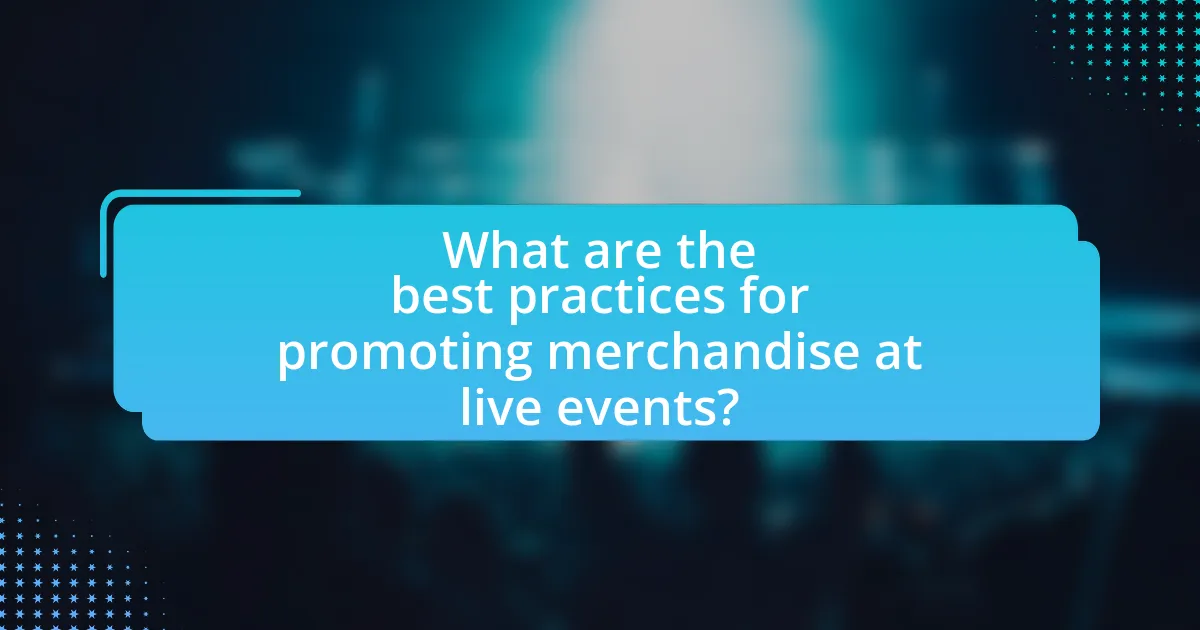
What are the best practices for promoting merchandise at live events?
The best practices for promoting merchandise at live events include creating visually appealing displays, engaging with the audience, and utilizing social media for real-time promotion. Visually appealing displays attract attention and can increase foot traffic to merchandise booths; studies show that well-designed displays can boost sales by up to 30%. Engaging with the audience through live demonstrations or interactive experiences fosters a connection and encourages purchases. Additionally, leveraging social media platforms during the event allows for immediate promotion, reaching a wider audience and driving traffic to merchandise sales. For instance, using event-specific hashtags can enhance visibility and engagement, leading to increased sales opportunities.
How can social media be utilized to boost merchandise sales?
Social media can be utilized to boost merchandise sales by creating targeted advertising campaigns that reach specific demographics. These campaigns can leverage platforms like Facebook and Instagram, which have over 2.8 billion and 1 billion monthly active users respectively, to showcase merchandise through visually appealing posts and stories. Additionally, engaging with followers through interactive content, such as polls and giveaways, can increase brand loyalty and drive sales. According to a study by Sprout Social, 79% of consumers are more likely to purchase from a brand they follow on social media, highlighting the effectiveness of social media engagement in enhancing merchandise sales.
What types of content are most effective for merchandise promotion?
Visual content, such as high-quality images and videos, is most effective for merchandise promotion. This type of content captures attention and showcases products in an engaging manner, leading to higher conversion rates. According to a study by HubSpot, visual content is 40 times more likely to be shared on social media than other types of content, which amplifies reach and visibility for merchandise. Additionally, user-generated content, such as customer reviews and testimonials, builds trust and authenticity, further enhancing promotional efforts.
How can influencers or brand ambassadors enhance visibility?
Influencers and brand ambassadors enhance visibility by leveraging their established audiences to promote products or services. They create authentic connections with their followers, which increases trust and engagement. For instance, a study by Nielsen found that 92% of consumers trust recommendations from individuals over brands, highlighting the effectiveness of influencer marketing. Additionally, influencers often utilize social media platforms to showcase merchandise, driving traffic and sales during live events. This strategy not only amplifies brand awareness but also encourages immediate purchasing decisions among their followers.
What are common challenges faced in merchandise sales at live events?
Common challenges faced in merchandise sales at live events include inventory management, pricing strategy, and payment processing. Inventory management is crucial as event organizers must accurately predict demand to avoid stockouts or excess unsold merchandise. A study by Eventbrite indicates that 60% of event organizers struggle with inventory forecasting, leading to lost sales opportunities. Pricing strategy is another challenge; setting prices too high can deter purchases, while prices that are too low may not cover costs. Additionally, payment processing issues, such as slow transaction times or limited payment options, can frustrate customers and result in lost sales. According to a survey by Square, 30% of vendors reported payment processing delays as a significant barrier to sales at events.
How can event organizers address inventory shortages?
Event organizers can address inventory shortages by implementing real-time inventory tracking systems. These systems allow organizers to monitor stock levels continuously, enabling them to make informed decisions about restocking or reallocating resources during an event. For instance, a study by the National Retail Federation found that businesses using real-time inventory management can reduce stockouts by up to 30%, ensuring that popular merchandise remains available for attendees. Additionally, establishing partnerships with local suppliers can provide quick access to additional inventory, further mitigating shortages.
What strategies can mitigate pricing conflicts with vendors?
To mitigate pricing conflicts with vendors, establishing clear communication and setting transparent pricing agreements is essential. This approach ensures that both parties understand the pricing structure and expectations, reducing misunderstandings. Additionally, conducting regular market research to align pricing strategies with industry standards can help maintain competitive pricing while fostering trust. Implementing a collaborative negotiation process allows for flexibility and compromise, which can further alleviate potential conflicts. According to a study by the Institute for Supply Management, effective communication and collaboration in vendor relationships can lead to a 20% reduction in pricing disputes.
What practical tips can help improve merchandise sales at live events?
To improve merchandise sales at live events, implement strategic pricing, engaging displays, and effective promotion. Strategic pricing involves setting competitive prices that reflect the perceived value of the merchandise, which can increase sales volume. Engaging displays attract attention; for example, using eye-catching signage and organized layouts can enhance visibility and encourage purchases. Effective promotion, such as offering limited-time discounts or bundling products, creates urgency and incentivizes attendees to buy. Research indicates that events with well-structured merchandising strategies can see sales increases of up to 30%, demonstrating the effectiveness of these practical tips.


